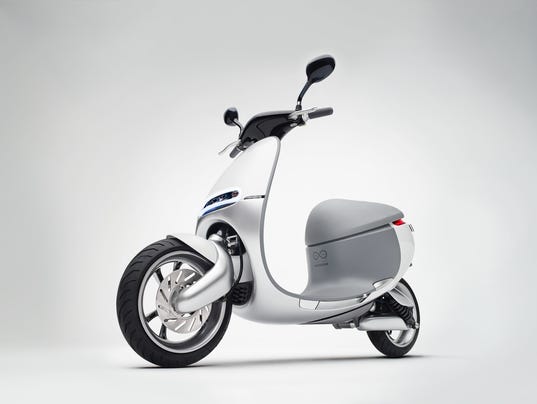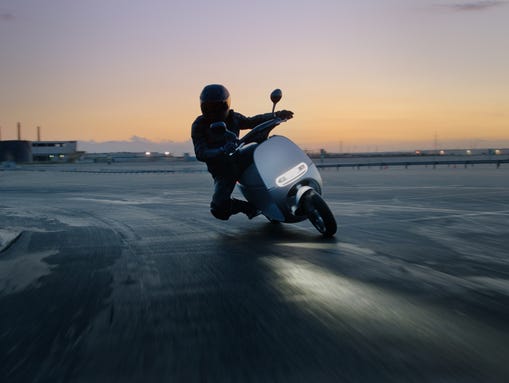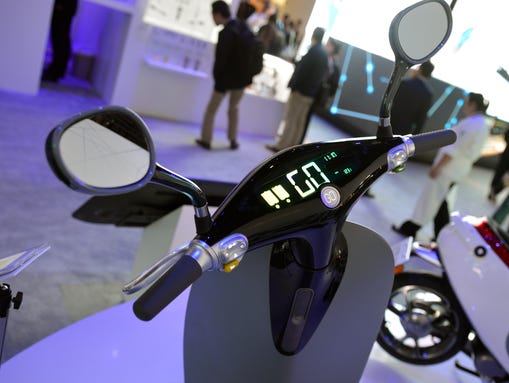This smart electric scooter doesn't need to be charged

USAToday.com: The transportation revolution isn't some elusive vision on the horizon. It has already begun, and we have smartphones to thank.
From Tesla to Uber, the most exciting innovations in automobile transportation are all arriving in the form of streamlined user experiences. But thus far the major breakthroughs have been squarely in the world of cars. What about, say, scooters?
If you live in suburban America, driving a scooter probably makes about as much sense as riding a horse to work. But in large cities around the world, scooters are an enormously popular and effective means of transportation. The problem is, they'reheavy polluters.
The Gogoro Smartscooter is an ingenious solution to that problem, as well as the frustrating patchwork of existing EV charging networks.
Instead of relying on third-party charging stations, Gogoro plans to launch a battery-swapping network that will allow users to roll up, grab a new battery (installation takes just six seconds), and deposit their old one, which then gets charged for the next person.
The company is partnering with Panasonic to get the job done, and its design involves a twin-battery system that provides enough power for 62 miles of travel and a top speed of 60 mph.
The biggest benefit of this system is the total lack of greenhouse emissions—a feature that could drastically alter the energy infrastructure of urban transit systems. Horace Luke, co-founder and CEO of Gogoro, sees the Smartscooter and EVs like it as an imperative for coming generations.

The Gogoro Smartscooter could have big implications for America's urban infrastructure. (Photo: Gogoro)
"It is essential that we reimagine the energy infrastructure and create a renewed mindset for change in tomorrow's urban generation," he said at the Consumer Electronics Show in Las Vegas, where the Smartscooter was unveiled.
"The Smartscooter and Gogoro Energy Network will capture the hearts of the next generation and become a catalyst for more efficient, cleaner, and smarter energy choices in our cities."
A zero-emission battery-swapping system is clever, but the scooter's smart infrastructure is equally impressive. The scooter itself features 55 sensors, cloud connectivity, an integrated app, and Bluetooth and NFC connectivity.
The Gogoro App, which syncs with the scooter via Bluetooth, locates "GoStations" throughout your city. You can also use it to reserve batteries and track ride details like top speed and range.

Check out the Smartscooter's nifty digital dashboard. (Photo: Reviewed.com)
One of the coolest features, simply called "Smart Mode," uses data gathered on your individual riding pattern and style to optimize your power consumption. For example, it might dim the lights to ensure your battery lasts long enough to get you home.
Gogoro hasn't skimped on hardware, either. The Smartscooter features an ultra-lightweight aluminum chassis, high-performance race suspension, an aerodynamic frame, hybrid racing tires, and a motor controller with digital processing.
That's pretty impressive, but if you're looking for speed and power, the Gogoro's 8.58 horsepower and 60 mph max speed are no match for what larger electric motorcycles can do. Harley-Davidson's LiveWire electric motorcycle, for example, boasts 74 HP and a top speed of 95 mph. But the Smartscooter is about efficiency above all else.
It's fair to remain skeptical that a company like Gogoro can pull all of this off. After all, you can't currently buy a Smartscooter, and the Energy Network is still in the planning stages. But the company does have a generous funding base.
When Gogoro first launched in 2011, it secured $50 million in Series A funding from a number of important Asian investors. The company is currently involved in a $100 million round of funding to bolster its planned 2015 rollout.
Gogoro has yet to announce where it plans to launch its first Energy Network. But given the popularity of scooters in Europe and the company's funding base in Asia, you can probably expect the U.S. to be far down the list.

USAToday.com: The transportation revolution isn't some elusive vision on the horizon. It has already begun, and we have smartphones to thank.
From Tesla to Uber, the most exciting innovations in automobile transportation are all arriving in the form of streamlined user experiences. But thus far the major breakthroughs have been squarely in the world of cars. What about, say, scooters?
If you live in suburban America, driving a scooter probably makes about as much sense as riding a horse to work. But in large cities around the world, scooters are an enormously popular and effective means of transportation. The problem is, they'reheavy polluters.
The Gogoro Smartscooter is an ingenious solution to that problem, as well as the frustrating patchwork of existing EV charging networks.
Instead of relying on third-party charging stations, Gogoro plans to launch a battery-swapping network that will allow users to roll up, grab a new battery (installation takes just six seconds), and deposit their old one, which then gets charged for the next person.
The company is partnering with Panasonic to get the job done, and its design involves a twin-battery system that provides enough power for 62 miles of travel and a top speed of 60 mph.
The biggest benefit of this system is the total lack of greenhouse emissions—a feature that could drastically alter the energy infrastructure of urban transit systems. Horace Luke, co-founder and CEO of Gogoro, sees the Smartscooter and EVs like it as an imperative for coming generations.

The Gogoro Smartscooter could have big implications for America's urban infrastructure. (Photo: Gogoro)
"It is essential that we reimagine the energy infrastructure and create a renewed mindset for change in tomorrow's urban generation," he said at the Consumer Electronics Show in Las Vegas, where the Smartscooter was unveiled.
"The Smartscooter and Gogoro Energy Network will capture the hearts of the next generation and become a catalyst for more efficient, cleaner, and smarter energy choices in our cities."
A zero-emission battery-swapping system is clever, but the scooter's smart infrastructure is equally impressive. The scooter itself features 55 sensors, cloud connectivity, an integrated app, and Bluetooth and NFC connectivity.
The Gogoro App, which syncs with the scooter via Bluetooth, locates "GoStations" throughout your city. You can also use it to reserve batteries and track ride details like top speed and range.

Check out the Smartscooter's nifty digital dashboard. (Photo: Reviewed.com)
One of the coolest features, simply called "Smart Mode," uses data gathered on your individual riding pattern and style to optimize your power consumption. For example, it might dim the lights to ensure your battery lasts long enough to get you home.
Gogoro hasn't skimped on hardware, either. The Smartscooter features an ultra-lightweight aluminum chassis, high-performance race suspension, an aerodynamic frame, hybrid racing tires, and a motor controller with digital processing.
That's pretty impressive, but if you're looking for speed and power, the Gogoro's 8.58 horsepower and 60 mph max speed are no match for what larger electric motorcycles can do. Harley-Davidson's LiveWire electric motorcycle, for example, boasts 74 HP and a top speed of 95 mph. But the Smartscooter is about efficiency above all else.
It's fair to remain skeptical that a company like Gogoro can pull all of this off. After all, you can't currently buy a Smartscooter, and the Energy Network is still in the planning stages. But the company does have a generous funding base.
When Gogoro first launched in 2011, it secured $50 million in Series A funding from a number of important Asian investors. The company is currently involved in a $100 million round of funding to bolster its planned 2015 rollout.
Gogoro has yet to announce where it plans to launch its first Energy Network. But given the popularity of scooters in Europe and the company's funding base in Asia, you can probably expect the U.S. to be far down the list.